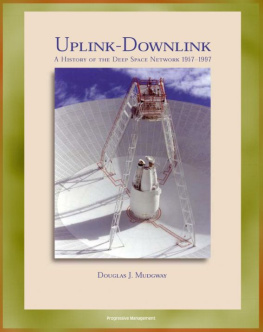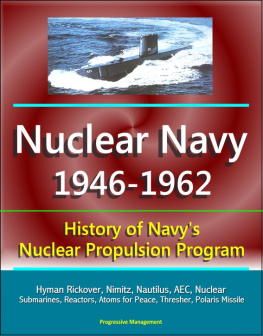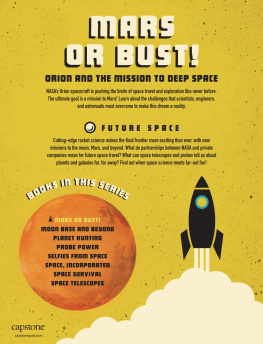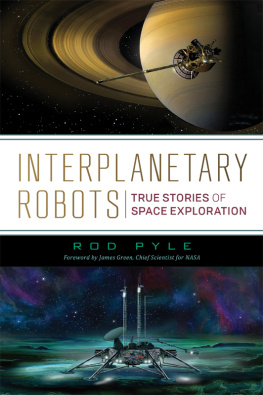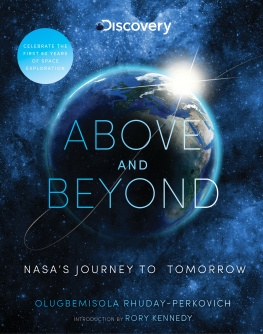Uplink - Downlink: A History of the DeepSpace Network 1957-1997, Mariner, Viking, Voyager, Galileo, CassiniEras, DSN as a Scientific Instrument (NASA SP-2001-4227)
National Aeronautics and Space Administration(NASA), World Spaceflight News, Douglas J. Mudgway
Smashwords Edition
Copyright 2012 Progressive Management
Questions? Suggestions? Comments? Concerns?Please contact the publisher directly at
Remember, the book retailer can't answer yourquestions, but we can!
* * * * * * * * * * *
Smashwords Edition, License Notes
This ebook is licensed for your personalenjoyment only. This ebook may not be re-sold or given away toother people. If you would like to share this book with anotherperson, please purchase an additional copy for each person youshare it with. If you're reading this book and did not purchase it,or it was not purchased for your use only, then you should returnto Smashwords.com and purchase your own copy. Thank you forrespecting the hard work of this author.
* * * * * * * * * * *
This is a privately authored news service andeducational publication of Progressive Management. Our publicationssynthesize official government information with original material -they are not produced by the federal government. They are designedto provide a convenient user-friendly reference work to uniformlypresent authoritative knowledge that can be rapidly read, reviewedor searched. Vast archives of important data that might otherwiseremain inaccessible are available for instant review no matterwhere you are. This e-book format makes a great reference work andeducational tool. There is no other reference book that is asconvenient, comprehensive, thoroughly researched, and portable -everything you need to know, from renowned experts you trust. Forover a quarter of a century, our news, educational, technical,scientific, and medical publications have made unique and valuablereferences accessible to all people. Our e-books put knowledge atyour fingertips, and an expert in your pocket!

Uplink - Downlink: A History of the DeepSpace Network -1957-1997
NASA SP-2001-4227
Douglas J. Mudgway
The NASA History Series
National Aeronautics and Space Administration* Office of External Relations * Washington, DC 2001
* * * * * * * * * * * *
CONTENTS
* * * * * * * * * * * *
* * * * * * * * * * * *
ACKNOWLEDGMENTS
To have been part of the history recordedhere is sufficient reason in itself to acknowledge my indebtednessto many colleagues in the DSN who supported and assisted methroughout my long and rewarding career at the Jet PropulsionLaboratory (JPL). That said, there remains the need to recognizethe important contributions that were made to the writing of thishistory by many of those engineers and scientists, and by otherpersons less directly associated with my life in the Deep SpaceNetwork.
I must begin with Nicholas A. Renzetti, forit was he who brought me from Australia to the United States in1962 to begin a career at the Deep Space Instrumentation Facility(DSIF), and it was he who, in 1996, after I had retired from JPL,stimulated my personal interest in producing a history of the DeepSpace Network. When the project began to falter for lack of fundingsupport, MacGregor Reid provided much needed encouragement, andPaul Westmoreland responded with the limited resources available tohim to keep it going.
Later, when those resources expired, theproject came to the attention of the NASA Chief Historian, RogerLaunius. His encouragement, backed with adequate resources, movedthe project rapidly forward to completion. Without his enthusiasticsupport it is unlikely this book would have been published. Alongthe way, I was ably assisted by Louise Alstork and other members ofthe NASA History Office staff.
As the work got under way, my access tohistorical documents, files, and photographs was eased immeasurablyby the generous help of members of the JPL Archives and Recordssection, notably John Bluth, Elizabeth Moorthy, and RobinMorris.
At all times, Shirley Wolff of theTelecommunications and Missions Operations (TMO) Outreach Officewas my lifeline to the daily pulse of the Network. I came to dependon her patience and energy for transmitting documents and othertechnical material provided, at my request, by various engineersand scientists associated with the Network. She, too, helped inbringing this project to life.
Last and longest, but by no means least,were the contributions in the form of interviews, discussions,technical briefings and materials, narrative reviews, andencouragement on various DSN-related topics that were provided by:Catherine Thornton on geodesy; Michael Klein on the search forextraterrestrial intelligence; Martin Slade on radar astronomy;James Hodder on network operations; Thomas Kuiper, Marvin Wick, andPamela Wolken on radio astronomy; George Textor on Voyager; LeslieDeutsch on DSN telemetry for Galileo; Joseph Wackley for DSNsystems; Joseph Statman on the Big Viterbi Decoder; Robert Wallaceon 34-m antennas; Dan Bathker on microwaves; Robert Clauss onmasers; Charles Stelzried on system noise temperature, VenusBalloon, and Giotto; Bob Preston and John Ovnick on orbiting VLBI;Fred McLaughlin on the 70-m antennas; Dale Wells on 70-m antennamaintenance; James Layland on coding and arraying; Patrick Beyer onGalileo; Dennis Enari on Ulysses and Mars Pathfinder; MarvinTraxler on Mars Observer; Allen Berman on Magellan; Robert White on34-m antennas; Thomas Wynne for photographs; Ronald Gillette onCassini; John McKinney on Mars Missions; Ed Massey on Voyager andUlysses; Nick Fanelli and Joe Goodwin on the Earth orbiters andreimbursables; Bob Ryan and David Lozier (Ames Research Center) onthe Pioneers; Michael Stewart on Magellan; Don Mischel, Tom Reid,Richard Mallis, and Robertson Stevens for early backgroundmaterial; George Schultz for an early draft; and finally, OliviaTyler, Bobby Buckmaster, and Lynda McKinley for miscellaneous butnevertheless indispensable help.
The onerous task of reviewing the draftversion of the book was undertaken by Larry Dumas, Michael Hooks,Roger Launius, MacGregor Reid, Gael Squibb, and Jose Urech. Theirinsightful comments and suggestions greatly enhanced the accuracy,consistency, and quality of the narrative.
The families of Nicholas Renzetti andWilliam Merrick kindly provided background material on the personallives of these two important figures in the history of the DeepSpace Network. Their contributions are gratefully acknowledged.
Douglas J. Mudgway
Sonoma, California
* * * * * * * * * * * *
FOREWORD
From the very beginning of its associationwith NASA in 1958, the Jet Propulsion Laboratory (JPL) received itsfair share of public recognition for its successes and failures inpursuing the exploration of deep space. It started with theExplorers, the first American satellites to orbit Earth. Laterthere came the Rangers, the first spacecraft to reach the surfaceof the Moon; the Mariner spacecraft, first to visit Venus and Mars;and the Voyagers that pushed the boundaries of deep spacecommunication further out to Jupiter and Saturn, and eventually toUranus and Neptune. There were other spacecraft that put landers,probes, or orbiters into planetary orbits or atmospheres, or ontoplanetary surfaces. There were probes whose mission was to explorethe composition and dynamics of the interplanetary medium, andprobes to observe the physics of the Sun. There were the hugemissions, such as Viking to Mars, Galileo to Jupiter, and Cassinito Saturn, and there were small missions like Pathfinder to Marsand the New Millennium missions to asteroids and comets. There wasalso science that did not require a spacecraft for its experimentssuch as radio astronomy, radar astronomy, and the search forextraterrestrial intelligence.
Next page
